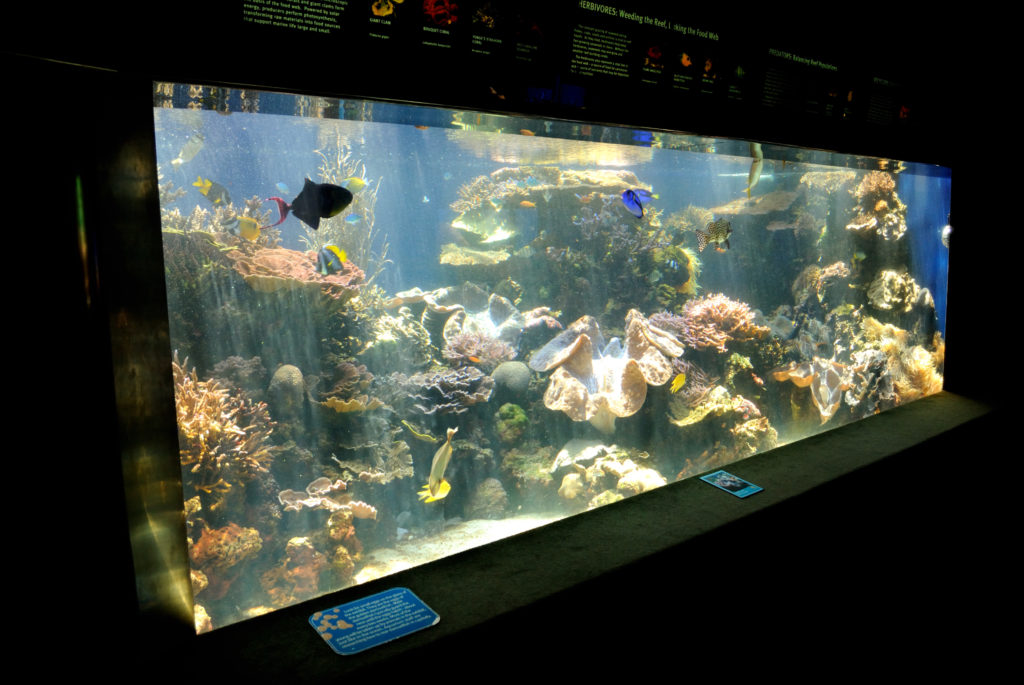Choosing Your Fish Tank
The aquarium tank is obviously one of the most important pieces of aquarium equipment you’ll need. The type of aquarium you select will depend on how much you want to spend, how much space you have, and the number and type of fish you plan on putting in it.
Aquariums come in either glass or acrylic, but you can find an assortment of shapes and sizes in both glass and acrylic. If you are willing to spend more money, custom fish tanks are also an option.
Here are some important frequently asked questions about choosing the right kind of aquarium:
What is the right size aquarium for me?
Can I use a glass bowl to keep my fish?
Why should I consider an acrylic aquarium?
Fish Tank Dimensions: What is the right size aquarium for me?
The right size of an aquarium depends on many factors: space available, size and number of fish you want to keep, your experience in keeping fish, and your budget. If you are just starting out as a fish keeper, consider either a 20 gallon or a 29 gallon aquarium. While smaller tanks are less expensive, as a general rule, the more water you have the easier it is to maintain stable water chemistry and temperature. Stable water conditions generally lead to happier and healthier fish.
In determining where you can put your aquarium don’t forget how much your fully equipped aquarium will weigh. With water, gravel and decorations your tank could easily weigh 12 pounds or more per gallon in size. That’s 240 pounds for a 20 gallon tank, and 1,200 pounds for a 100 gallon fish tank. You will need a stable base for your aquarium. You should consider a stand made especially for an aquarium. Furniture is not always made to hold all this weight.
A glass aquarium is basically a glass “box” formed using individual pieces of glass held together with heavy plastic top and bottom frames. Silicone is used to seal between the glass pieces and the frame. The silicone seal not only prevents leaks, but also cushions one piece of glass against the other, which aids in preventing pressure cracks. Glass aquariums are warranted against pressure cracks and leaks.
Glass aquariums are very easy to clean, they don’t scratch as easily as acrylic, and they are generally less expensive than acrylic. They’re made in a wide variety of shapes and sizes – from 5 gallon up to 240 gallons and larger. Traditionally, glass aquariums came only in square or rectangles. However, new technologies now make bending of glass possible and glass aquariums now come in many new and inviting shapes and sizes. There are also a new type of glass fish tank called a rimless fish tank. The glass in a rimless fish tank only contains low iron and doesn’t have any green hue. This means that the glass is extra clear and perfect for viewing your tank.
Can I use a glass bowl to keep my fish?
Glass bowls are very inexpensive, and you don’t have to worry about leaks. However, your fish will be happiest and healthiest in an aquarium with a filtration and aeration system. If you decide to keep fish in a glass bowl, choose a fish such as a betta that can breathe at the surface of the water. Remember that without a filtration system you will need to change the water more frequently and frequently results in a cloudy fish tank.
If you have limited space, consider a 2 gallon or 5 gallon plastic aquarium. These units typically come as a starter kit with a filtration system, air pump and light. You can only keep one or two fish in these tanks but they make a nice addition to an office, bedroom or kitchen counter. If you purchase a 5 gallon aquarium, make sure to purchase a five gallon fish tank filer.
Why Should I Consider an Acrylic Aquarium?
Acrylic aquariums are more expensive than glass aquariums, but there are a number of advantages that account for the difference in price. Also, remember that in large aquariums the cost differences between glass and acrylic aquariums are generally much less.
Acrylic aquariums are constructed by using a solvent to weld the seams. This technique assures that an acrylic aquarium will rarely develop a leak. After the aquarium is assembled, the solvent evaporates and the seams become stronger than the acrylic itself. These solvents pose absolutely no danger to the fish within the aquarium. Silicone seams can discolor with age; solvent used in acrylic aquariums does not yellow with age.
Acrylic is 17 times stronger than glass and will flex instead of shatter. This makes it virtually childproof. Because the seams are stronger and the aquarium is more flexible, you can count on having an acrylic aquarium longer. It’s also more clear than glass, and is a better insulator than glass, which means it takes less energy to heat the aquarium. Acrylic weighs half as much as glass, and the bent corners and fewer seams on an acrylic aquarium adds a sleek design to the tank.
One drawback of acrylic aquariums is the tendency for scratches. However, scratches can be removed or lightened from acrylic whereas it is impossible to remove a scratch from glass. Because acrylic aquariums can scratch easily, only those scrubbers that indicate “can be used on acrylic” should be used. Never use an ammonia product when cleaning the outside of an acrylic aquarium because ammonia will crystallize acrylic. Use only a vinegar and water solution for cleaning the outside of an acrylic aquarium.
Usually, acrylic aquariums typically come with a hood and fluorescent accessory that is compatible with the fish tank.
We are happy to announce that Fish Tank Expert was selected as one of the Top 30 Aquarium Blogs by Feedspot!
